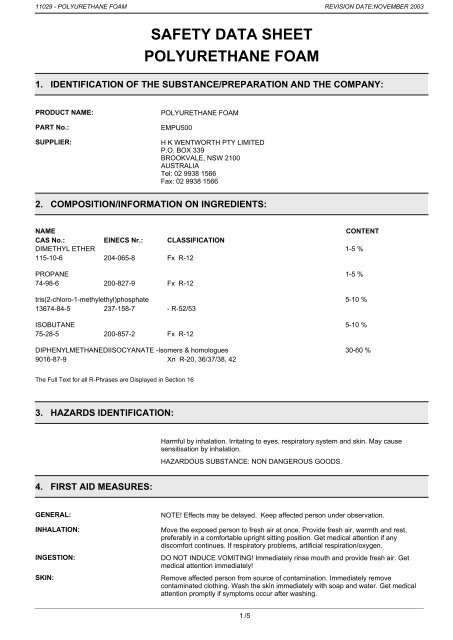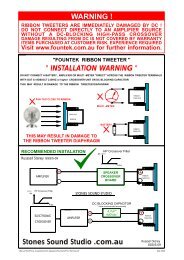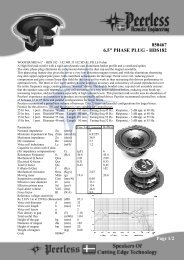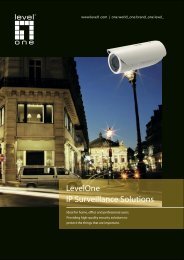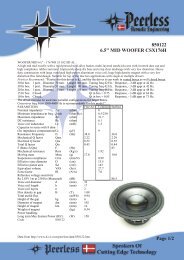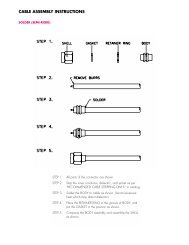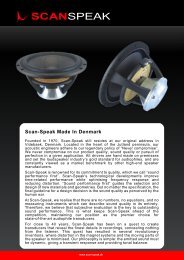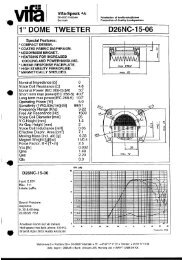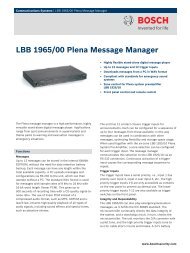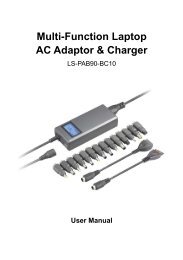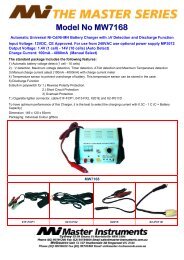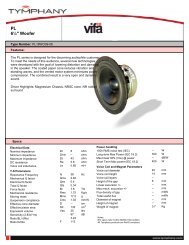SAFETY DATA SHEET POLYURETHANE FOAM - WES Components
SAFETY DATA SHEET POLYURETHANE FOAM - WES Components
SAFETY DATA SHEET POLYURETHANE FOAM - WES Components
You also want an ePaper? Increase the reach of your titles
YUMPU automatically turns print PDFs into web optimized ePapers that Google loves.
11029 - <strong>POLYURETHANE</strong> <strong>FOAM</strong> REVISION DATE:NOVEMBER 2003<strong>SAFETY</strong> <strong>DATA</strong> <strong>SHEET</strong><strong>POLYURETHANE</strong> <strong>FOAM</strong>1. IDENTIFICATION OF THE SUBSTANCE/PREPARATION AND THE COMPANY:PRODUCT NAME:PART No.:SUPPLIER:<strong>POLYURETHANE</strong> <strong>FOAM</strong>EMPU500H K WENTWORTH PTY LIMITEDP.O. BOX 339BROOKVALE, NSW 2100AUSTRALIATel: 02 9938 1566Fax: 02 9938 15662. COMPOSITION/INFORMATION ON INGREDIENTS:NAMECAS No.:DIMETHYL ETHER115-10-6PROPANE74-98-6EINECS Nr.: CLASSIFICATION204-065-8 Fx R-12200-827-9 Fx R-12CONTENT1-5 %1-5 %tris(2-chloro-1-methylethyl)phosphate13674-84-5 237-158-7 - R-52/535-10 %ISOBUTANE75-28-5200-857-2 Fx R-125-10 %DIPHENYLMETHANEDIISOCYANATE -Isomers & homologues9016-87-9Xn R-20, 36/37/38, 4230-60 %The Full Text for all R-Phrases are Displayed in Section 163. HAZARDS IDENTIFICATION:Harmful by inhalation. Irritating to eyes, respiratory system and skin. May causesensitisation by inhalation.HAZARDOUS SUBSTANCE: NON DANGEROUS GOODS.4. FIRST AID MEASURES:GENERAL:INHALATION:INGESTION:SKIN:NOTE! Effects may be delayed. Keep affected person under observation.Move the exposed person to fresh air at once. Provide fresh air, warmth and rest,preferably in a comfortable upright sitting position. Get medical attention if anydiscomfort continues. If respiratory problems, artificial respiration/oxygen.DO NOT INDUCE VOMITING! Immediately rinse mouth and provide fresh air. Getmedical attention immediately!Remove affected person from source of contamination. Immediately removecontaminated clothing. Wash the skin immediately with soap and water. Get medicalattention promptly if symptoms occur after washing.1 /5
11029 - <strong>POLYURETHANE</strong> <strong>FOAM</strong> REVISION DATE:NOVEMBER 2003EYES:Promptly wash eyes with plenty of water while lifting the eye lids. Make sure to removeany contact lenses from the eyes before rinsing. Continue to rinse for at least 15minutes and get medical attention. Get medical attention if any discomfort continues.5. FIRE FIGHTING MEASURES:EXTINGUISHING MEDIA:SPECIAL FIRE FIGHTINGPROCEDURES:UNUSUAL FIRE & EXPLOSIONHAZARDS:HAZARDOUS COMBUSTIONPRODUCTS:Fire can be extinguished using: Water spray, fog or mist. Foam. Powder.Avoid breathing fire vapours. Use pressurized air mask if substance is involved in a fire.Fire causes formation of toxic gases. Risk of explosion if pressure increases. Aerosolcans may explode in fires.Fire creates: Irritating gases/vapors/fumes of: Hydrogen cyanide (HCN). Nitrous gases(NOx).6. ACCIDENTAL RELEASE MEASURES:SPILL CLEANUP METHODS:In handling of spillage, please also consult the section detailing protective measures.Wear necessary protective equipment. Stop leak if possible without risk. Make a slurrywith water and absorb onto an inert material. Place in a closed container. Flush withplenty of water to clean spillage area. Do not contaminate water sources or sewer.7. HANDLING AND STORAGE:USAGE PRECAUTIONS:STORAGE PRECAUTIONS:Persons with impaired lung functions should not handle this preparation. Personssusceptible for allergic reactions should not handle this product. Avoid spilling, skin andeye contact. Ventilate well, avoid breathing vapours. Use approved respirator if aircontamination is above accepted level.Keep in original container. Keep in cool, dry, ventilated storage and closed containers.Keep away from heat, sparks and open flame.8. EXPOSURE CONTROLS AND PERSONAL PROTECTION:INGREDIENT NAME: CAS No.: STD LT EXP 8 Hrs ST EXP 15 MinDIMETHYL ETHER115-10-6OES400 ppm 500 ppmPROPANE 74-98-6Asphyxiating AsphyxiatingDIPHENYLMETHANEDIISOCYANATE -Isomers & 9016-87-9homologuesMEL0.02 mg/m3 0.07 mg/m3INGREDIENT COMMENTS:PROTECTIVE EQUIPMENT:OES = Occupational Exposure Standard.VENTILATION:RESPIRATORS:PROTECTIVE GLOVES:EYE PROTECTION:OTHER PROTECTION:Provide adequate general and local exhaust ventilation.Respiratory protection must be used if air concentration exceeds acceptable level.SCBAF,PD,PP, Self-contained breathing apparatus with full facepiece operated inpressure-demand or other positive pressure mode.Use protective gloves made of: Rubber, neoprene or PVC.Use approved safety goggles or face shield.Wear appropriate clothing to prevent any possibility of liquid contact and repeated orprolonged vapour contact.2 /5
11029 - <strong>POLYURETHANE</strong> <strong>FOAM</strong> REVISION DATE:NOVEMBER 2003HYGIENIC WORK PRACTICES:DO NOT SMOKE IN WORK AREA! Wash at the end of each work shift and beforeeating, smoking and using the toilet. Promptly remove any clothing that becomescontaminated. Wash promptly if skin becomes contaminated. No eating or drinkingwhile working with this material.9. PHYSICAL AND CHEMICAL PROPERTIES:APPEARANCE:ODOUR/TASTE:DENSITY/SPECIFIC GRAVITY(g/ml):SOLUBILITY DESCRIPTION:Aerosol.Musty (mouldy).1.09 Temperature (°C): 25Insoluble in water.10. STABILITY AND REACTIVITY:STABILITY:CONDITIONS TO AVOID:HAZARDOUS DECOMP.PRODUCTS:Normally stable.Avoid heat, flames and other sources of ignition. Avoid contact with strong oxidisers.Reacts strongly with strong acids, bases, organic chemicals and certain metalcombinations.High temperatures generate: Toxic gases/vapours/fumes of: Carbon dioxide (CO2).Carbon monoxide (CO). Hydrogen cyanide (HCN).11. TOXICOLOGICAL INFORMATION:TOXIC DOSE - LD 50: >10000 mg/kg (oral rat)TOXIC CONC. - LC 50: 490 mg/l/4h (inh-rat)HEALTH HAZARDS, GENERAL:INHALATION:INGESTION:SKIN:EYES:OTHER HEALTH EFFECTS:No specific health warnings noted.Harmful by inhalation. High concentrations of vapours may irritate respiratory systemand lead to headache, fatigue, nausea and vomiting. May cause sensitisation byinhalation.May cause stomach pain or vomiting.Irritating to skin. Prolonged or repeated exposure may cause severe irritation.Irritating to eyes.This substance has no evidence of carcinogenic properties.12. ECOLOGICAL INFORMATION:ECOLOGICAL INFORMATION:Dangerous for the environment if discharged into watercourses.13. DISPOSAL CONSIDERATIONS:DISPOSAL METHODS:Dispose of in accordance with Local Authority requirements.14. TRANSPORT INFORMATION:3 /5
11029 - <strong>POLYURETHANE</strong> <strong>FOAM</strong> REVISION DATE:NOVEMBER 2003EU DIRECTIVES:Dangerous Substance Directive 67\548. System of specific information relating toDangerous Preparations. 91\155.16. OTHER INFORMATION:REVISION COMMENTS:ISSUED BY:Revised in accordance with CHIP3 and EU Directive 1999/45/ECHelen O'ReillyREVISION DATE: NOVEMBER 2003REV. No./REPL. SDS GENERATED: 0SDS No.: 11029DISCLAIMER:R-PHRASES (Full Text):This information relates only to the specific material designated and may not be validfor such material used in combination with any other materials or in any process unlessspecified in the text. The information contained in this safety data sheet is correct to thebest of our knowledge, information and belief at the date of its publication. Theinformation given is designed only as guidance for the safe handling, use, processing,storage, transportation, disposal and release and is not to be considered a warranty orquality specificationR-12 Extremely flammable. R-52/53 Harmful to aquatic organisms, may causelong-term adverse effects in the aquatic environment. R-20 Harmful by inhalation.R-36/37/38 Irritating to eyes, respiratory system and skin. R-42 May cause sensitisationby inhalation.5 /5


